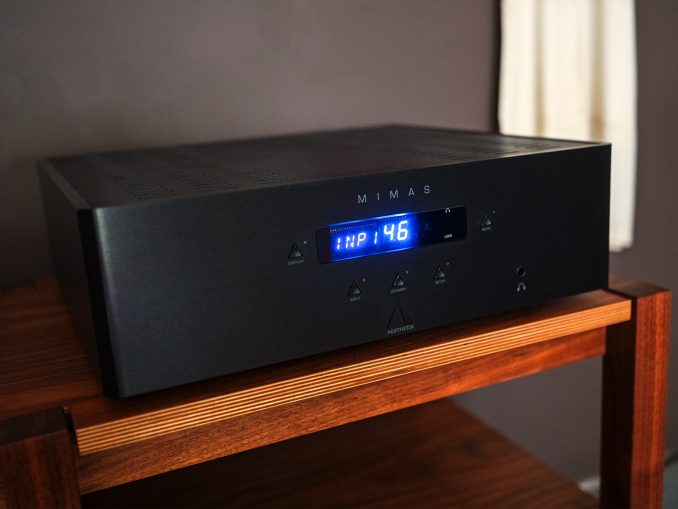
In today’s world of overload, that second-by-second flood of data, it’s kind of rare to find a quiet gem.
In hifi, those waves of data typically crest highest with news of a new product rippling around forums and social media from its initial drop, then over time things flatten back out waiting for the next big plop in the hifi pond. We reviewers tend to focus on the new for this very reason—we can ride the crest. Some reviewers even like to believe they’ve had a big hand in creating the initial impact with a World Premier! even though the product itself is always the prime mover without which reviewers would have nothing much to say.

The Aesthetix Mimas Integrated Amplifier was first released in 2019 to what I’d call rave reviews from a number of well established publications, written by well known and well respected reviewers including Ken Kessler for Hi-Fi News, Jason Victor Serinus for Stereophile, and Neil Gader for The Absolute Sound. Raves all around. What’s more, on a personal note a number of people I respect have been whispering “Mimas” in my ears for years so when the opportunity for a review recently aligned, I was thrilled at the prospect of getting my ears, brain, and body some Mimas time. All of me, why not take all of me?
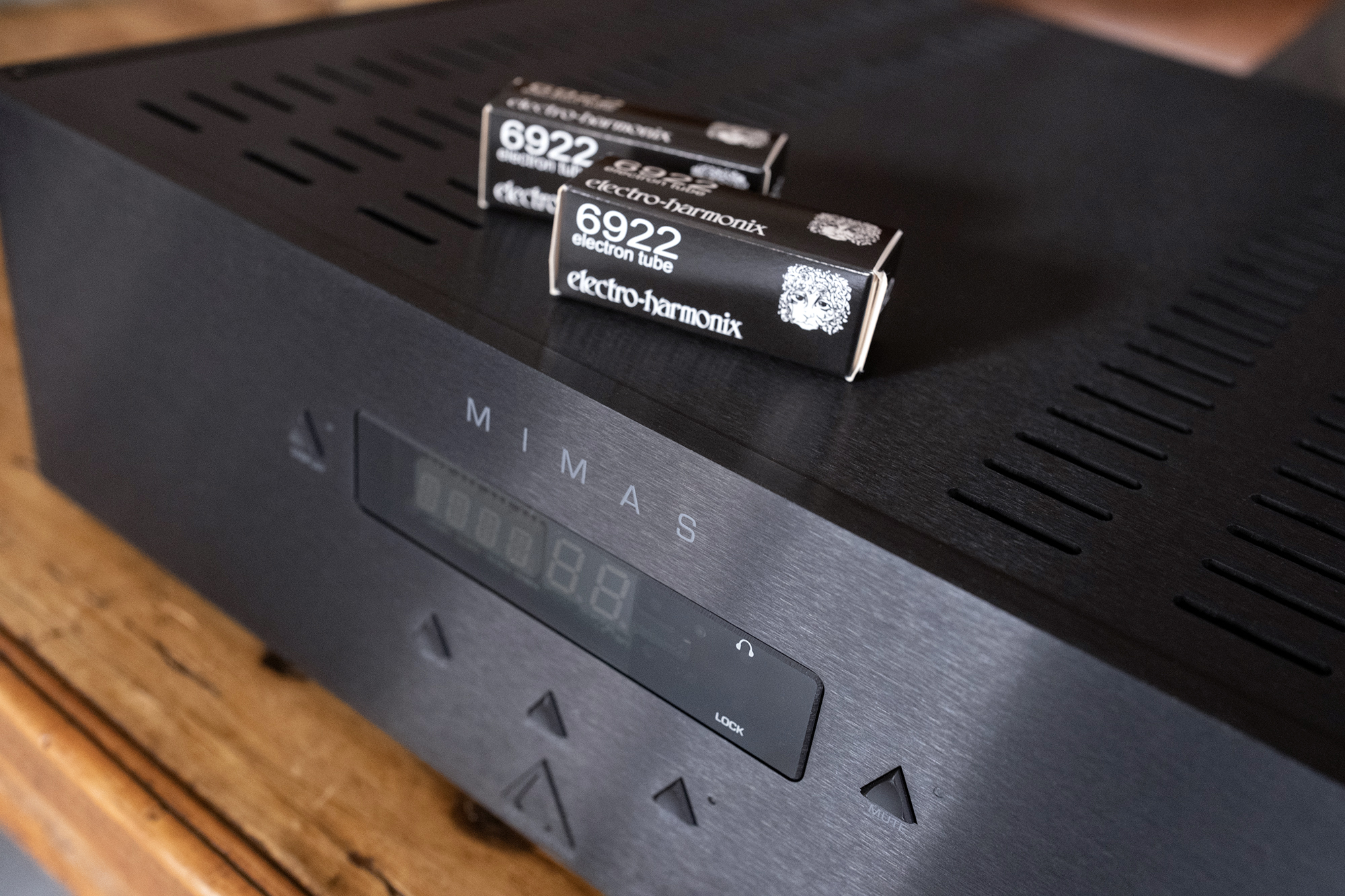
The Mimas is a hybrid integrated amplifier with a pair of 6DJ8 (6922) vacuum tubes in its preamplifier stage while a “fully differential, zero-feedback, DC coupled, balanced bridge output operating in Class AB” amplification stage adds up to 150W into 8 ohms, and about double that into 4.
I’m going to let the company talk about the Mimas a bit. Here’s Aesthetix on the volume control inside the Mimas:
The same volume control used in our award-winning Calypso was borrowed for use in the Mimas. It consists of 88 1dB steps, utilizing individual switched 1% metal film resistors. The volume control has long been considered one of the most difficult design challenges of a preamplifier, with more compromised designs utilizing potentiometers which impart the music with a dullness due to loss of detail. Others use inexpensive integrated circuit based volume controls which have good matching between channels and small step size but impart a hardness and glare to the sound. Our volume control avoids these pitfalls. It is costly, but worth it.
And on the power supply:
A key part of any Aesthetix piece is our devotion to overbuilt, advanced technology power supplies. Mimas is no different, incorporating no less than seven fully regulated power supplies. Fundamental to any power amplifier, the high current power supply is provided by a separate center tapped transformer winding capable of 750VA and feeding 176,800uF of capacitance for a total energy storage of over 110 Joules. The high voltage supply for the vacuum tubes is a fully discrete regulated supply with over 220uF of capacitance supplied by a separate high voltage transformer winding. Mimas’ input circuits are operated by a fully discrete regulated supply with over 4,400uF of supply capacitance. Vacuum tube heater supplies are fully DC regulated. The 900VA low flux power transformer, incorporating 5 separate secondary windings, is designed and manufactured by Aesthetix in our facility in Moorpark, Ca.
I include these quotes here and elsewhere because they offer valuable insight into aspects of design that the manufacturer attributes to performance, something we as reviewers and listeners can appreciate and perhaps learn from in a general sense without the real benefit of direct experience in the making. This kind of information also goes a long way in explaining why grouping all hybrid integrated amplifiers, or all tube amplifiers and so on, into the same sonic category makes about as much sense as thinking “dog” adequately describes them all.

In its basic configuration, the Mimas integrated offers a total of 10 inputs, 5 single-ended RCA and 5 balanced XLR, RCA and XLR Preamp outputs, and a pair of speaker binging posts on either side. The blank removable panels you see on the left side accommodate an optional MM/MC Phono card and optional DAC card. As you can see, I opted for the basic version. There’s also an optional fully discrete Class-AB 1 watt into 32 ohm headphone amplifier and a hardware adjustable high pass crossover for subwoofer-ers.
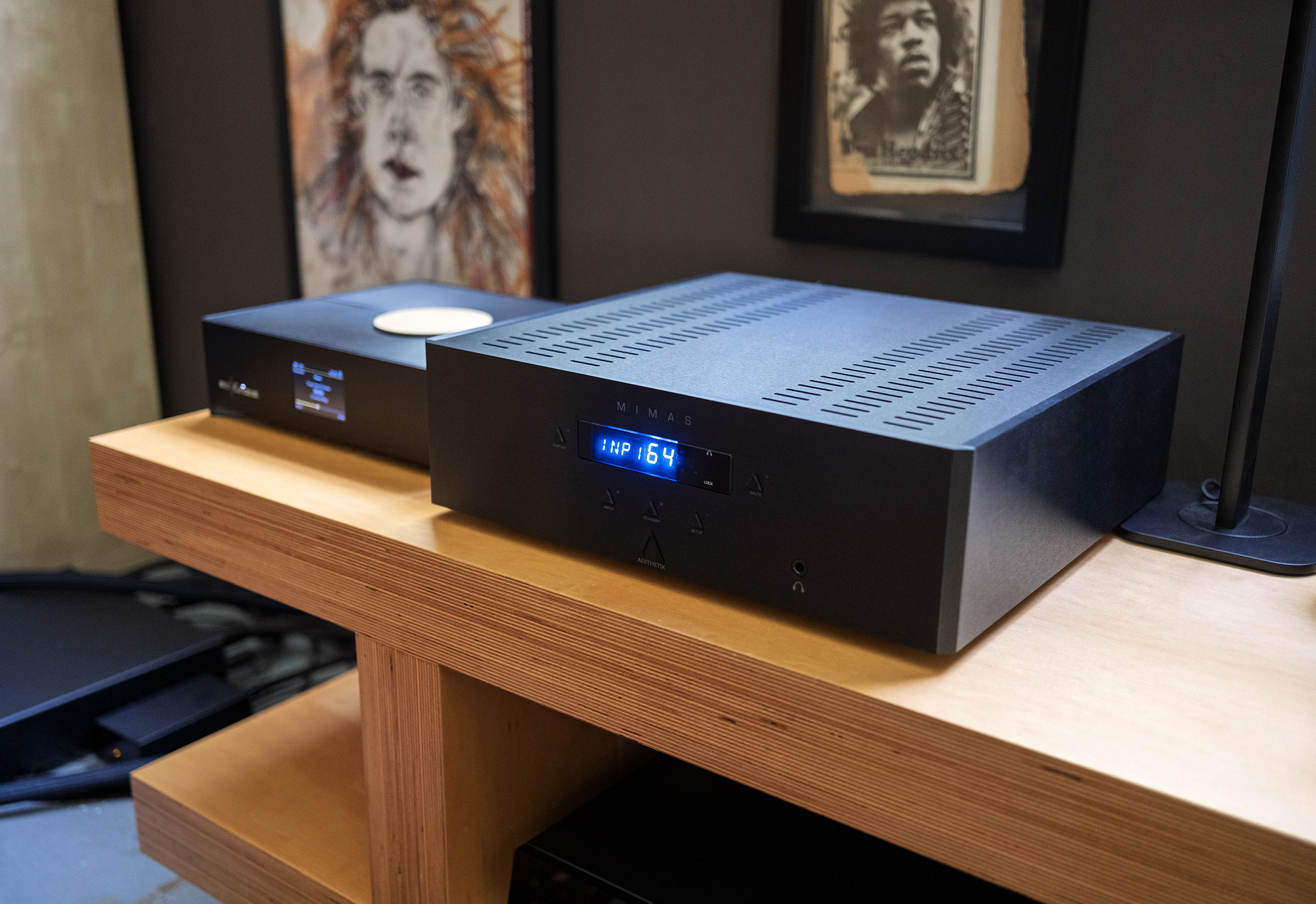
Five triangular-shaped buttons adorn the front panel around the blue ‘static LED’ display and are marked Display, Input, Standby, Setup, and Mute. If you don’t read the informative Mimas manual, something I did later than sooner (shame on me), you might wonder why there’s no volume control on the front panel? That’s odd! What’s perhaps odder still, but kinda cool, is volume is adjusted on the front panel by pressing the left or right side of the display to lower or raise the level. Ah ha! Sneaky! All to say, it always pays to read the manual before complaining about a perceived lack of functionality.
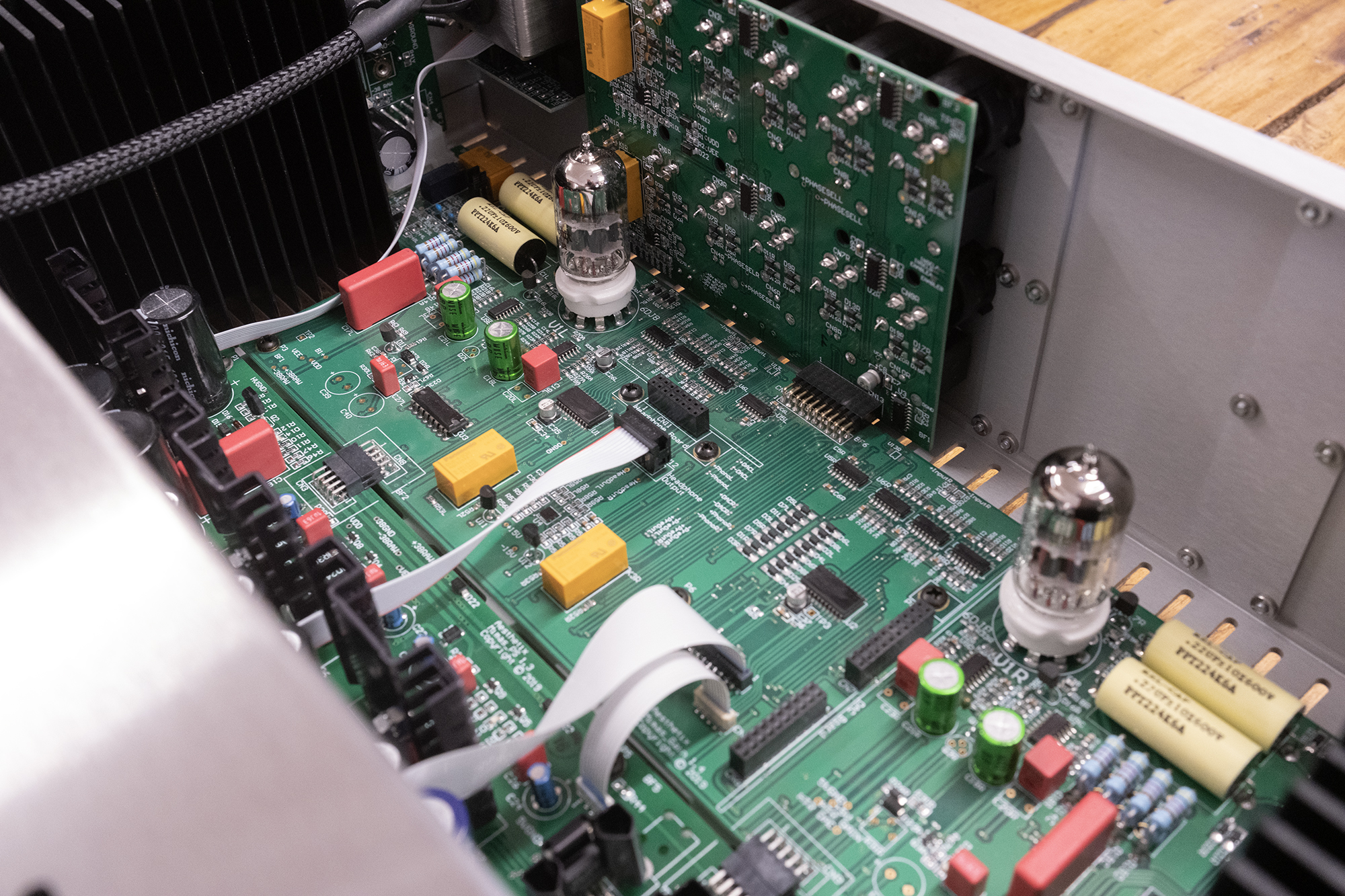
When the Mimas first arrived, I installed the 6DJ8s, placed the 44 lb. amp on my Box Furniture rack on the B-Side, made all the connections, checked ‘em twice, powered the Mimas on and sat down to play. After the initial “Warm Up” phase, which takes about 2 minutes but the actual amount of time is dependent on the temperature of the output module heatsinks, I hit “Play” in Roon and heard…nothing. Turns out, the Mimas starts up with Mute engaged, something I figured out thanks to the small blue LED’s glow next to the Mute button. This is also stated very clearly in the manual.
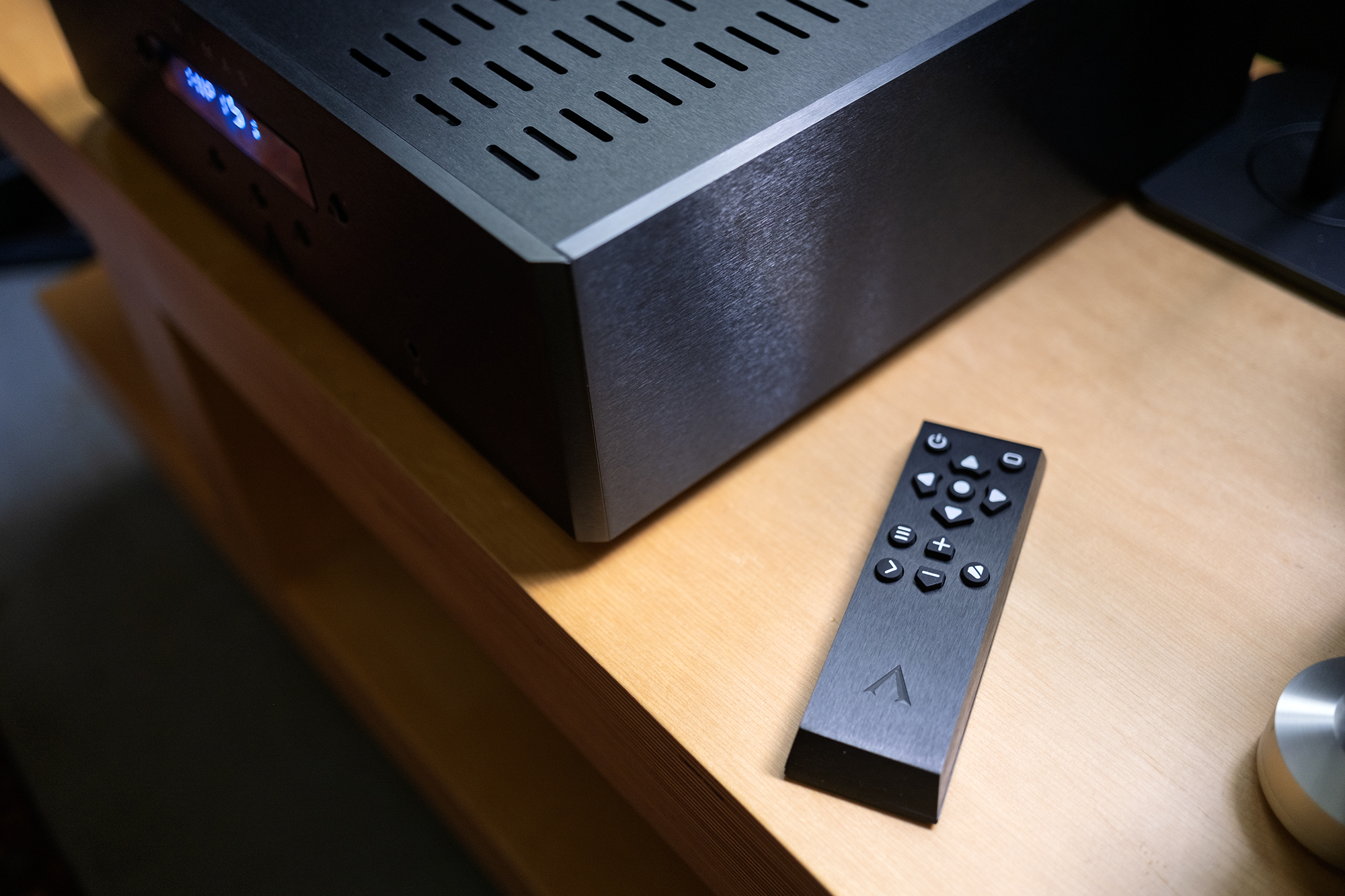
While we’re here in manual land, there are a number of setup options I will touch on briefly and send you over to the actual manual for the details. Setup options include Headphones (enable/disable the front headphone jack), Balance, Start Level (programmable range is 0-40), Maximum Level, IR (Infrared), Display, and Restore. Digging a bit deeper, you can also set the level for each input, enable Home Theater Bypass mode, name each input (up to 3 characters), and enable Bypass mode for fixed output.
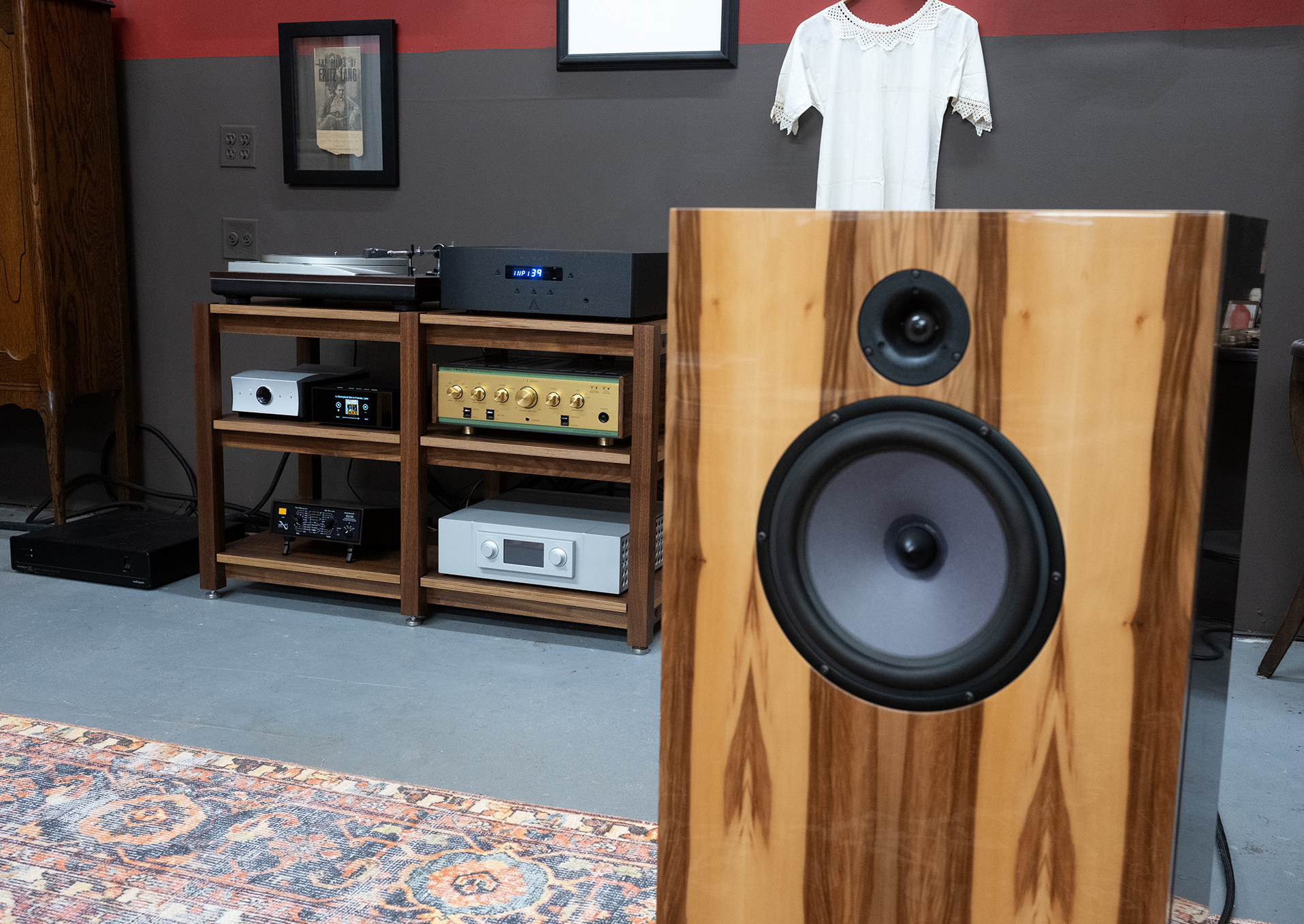
When paired with the DeVore O/96 (review), the Mimas quickly and not so quietly announced some of its standout skills that include excellent bass (control and performance), superb resolution that is at once fine-grained and natural sounding, and a sound image as big and clearly defined as the recording allows, which on some recordings is crazy, scary big. Contrary to some things I’ve read online, the O/96 love a good amp regardless of topology and the Mimas/O/96 made for a delightful, big, and physical presentation. When compared to other much more expensive amps like the Riviera Labs Levante (review), the Mimas holds up very well even though it does not offer the full 3-dimensional magic found in the Levante.
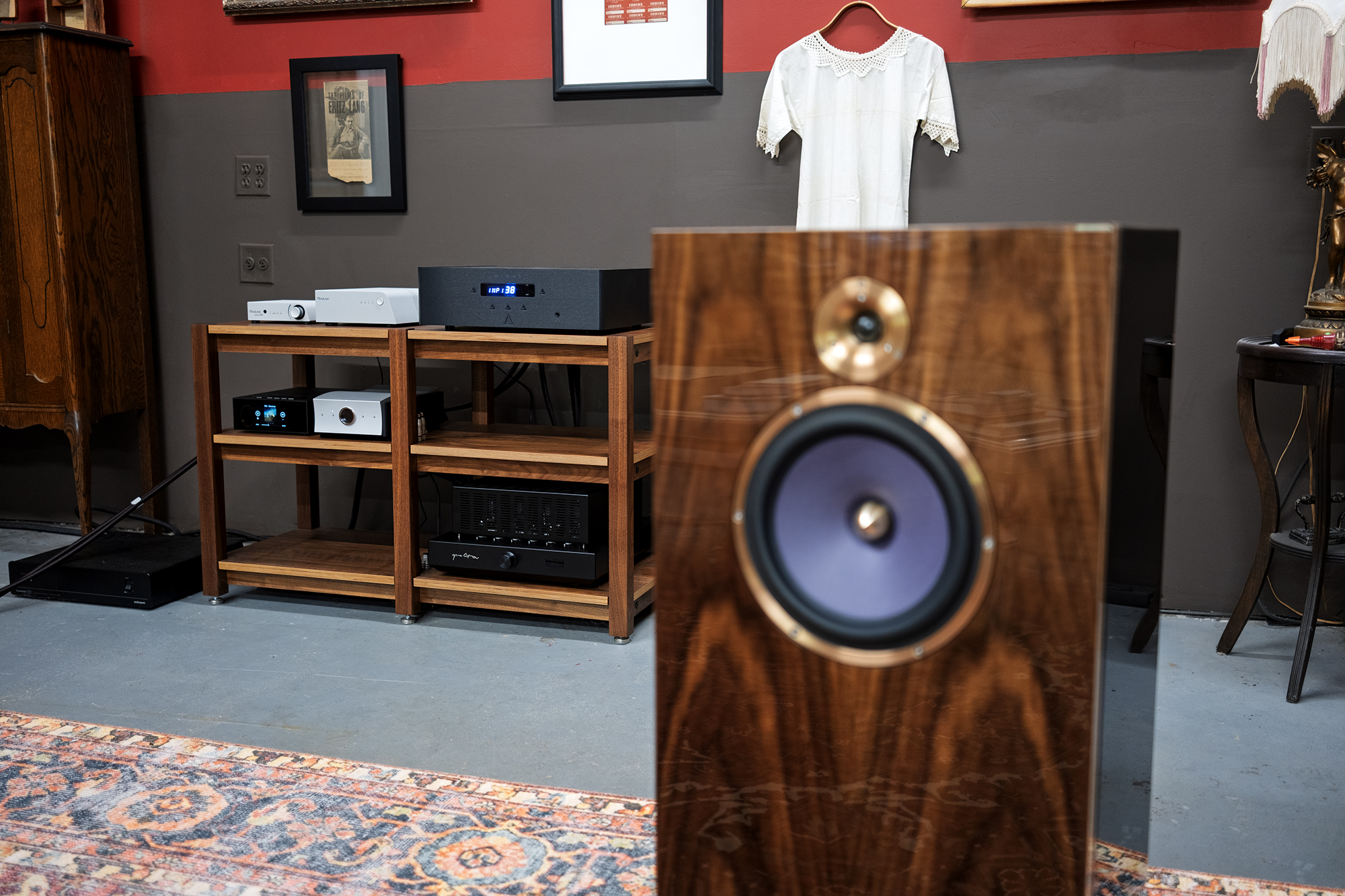
I also let the Mimas have some DeVore O/Bronze (more info) time and without letting the cat of the bag so to speak, the O/Bronze are better speakers than the O/96 which meant that the Mimas/O/Bronze combo had more to offer. I spent a lot of time listening to this pairing with the Barn resident Auralic S1 (review)/Mola Mola Tambaqui (review) front end as well as with the recently arrived Weiss Helios DAC (more info) and listening was a true adventure in sound with many a shocking moment thanks to the music in play.
The Mimas offers a level of performance I’ve come to associate with much more expensive gear and its combined strengths, not only with the DeVores but also with the Ø Audio, make it a stand out in the very crowded field of integrated amplifiers anywhere near its price. One direct comparison I would have loved to make is with the similarly priced ($9750) ModWright KWH 225i Hybrid Integrated (review) but that amp, which is also a hybrid design, left here three years ago. My recollection, after re-reading the ModWright review, is that the Mimas offers a bit more delicacy compared to ModWright’s burly drive.
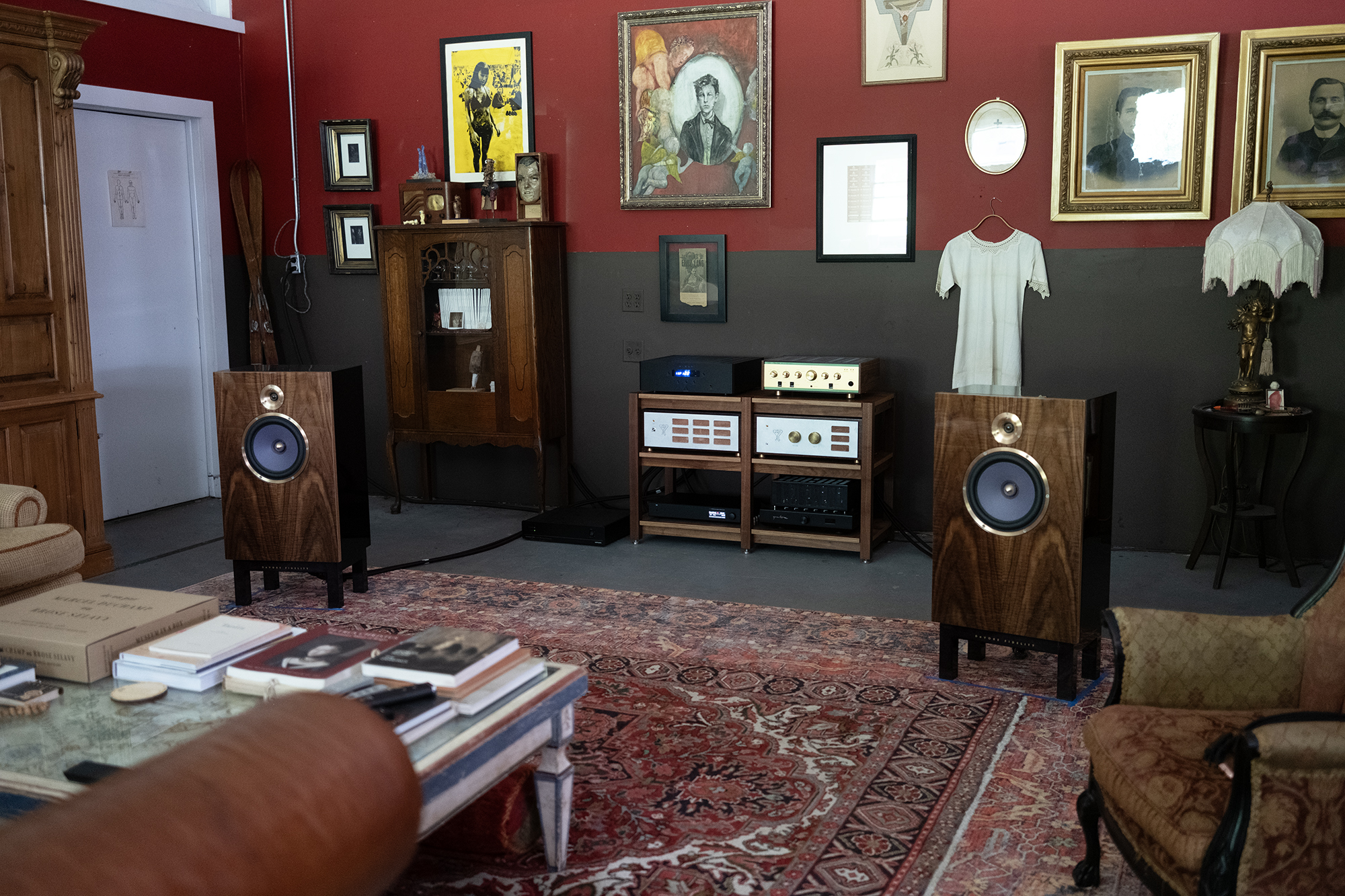
Then there’s the Barn resident Leben CS600X, an integrated amplifier that relies on 2 pair of EL34’s, or Genalex Gold Lion KT77s in my case, to produce about 28 Watts of output power. The Leben currently costs just under $9000, within $5 of the Mimas asking price. Right off the bat it’s worth highlighting one obvious difference that has to do with power—simply put the Mimas can drive a wider range of speakers. With that out of the way, let’s talk about the differences I heard with both amps driving the O/Bronze using the Weiss Helios DAC and a loom of AudioQuest cables including their brand new Brave Heart speaker cables (see full Barn and system details).
The Leben paints with a more heavily loaded brush making music sound and feel that much more saturated, that much more ripe even though this plays right into the ‘tube amplifiers have a sound’ cliche. Hey, I call it as I hear it. While the Leben also coaxed some nice big bass from the O/Bronze, that bass was less refined as heard through the Mimas. The Mimas also bettered the Leben in terms of overall resolution where large sound images, as are present on These New Puritans recent stunner Crooked Wing, were more clearly defined. For my tastes, I prefer the Leben on the O/96 which is my ‘reference’ setup and things get nearly too close to call on the O/Bronze but my heart ultimately lies with the Leben when it comes to DeVore.
But I’m talking about a question of priorities which is a very personal matter. I also have some other newfound favorites for the O/Bronze which I’ll talk about in that review (they are much more expensive than the Mimas). When we get down to it, personal preferences and system building are inseparable from any review or when building the hifi of our dreams.

With this in mind, the Mimas/Ø Audio pairing made me sit up and say “Wow” much more than the Mimas/DeVore combo, so much so I feel I really heard the Mimas more fully strut its stuff with the big boys from Norway. To be clear, this is not a knock on the Mimas or the DeVores, rather it is a reflection on my reaction to the sound of the systems as a whole. Think of it this way—imagine a friend gives you a bottle of great red wine, not good but great, and you pair it with a bowl of Cheerios. That wine sucked! Cheerios are awful!
Perhaps more than other parts of a hifi, a loudspeaker’s appearance telegraphs aspects of its performance to a greater degree than a DAC or amp. More or less. The Verdande stand 45” tall and over 19” wide with its Quad Vertex SoundField Horn stretching from side-to-side paired with a 15” woofer. Woof! Big and stout.
caroline 2 by London-based octet caroline was released on May 30th on Rough Trade and like its self-titled predecessor, this album is wonderfully adventurous, free, and free flowing between genres, sounds, styles, and moods.
From the liner notes:
Returning with ‘caroline 2’, the eight-piece collective embrace a bolder, more expansive sound. Going beyond their debut’s explorations of repetition, slowness and space, the new album pushes further into dynamic contrasts — organic and electronic, raw and refined.
A bolder more expansive sound is also a very nice way to walk into talking about the Mimas/Verdande pairing, which presented this music as a big, great ball of sonic energy well free from the confines of the speaker’s physical presence while also obliterating my expectations for the Mimas considering I recently completed a review of the $135k/pair Octave Jubilee ULTIMATE Monoblocks (review) which also saw some Verdande time. I’m not saying the Mimas are the Octave’s equal but what I am saying is the Mimas offers a very nice chunk of their performance. A very nice chunk that made the Verdande sing with a stunning voice that washed away thoughts of ‘what could be better…’.
This music mixes acoustic, electric, and eclectic sounds and vocals into a rich stew of storytelling over the course of the album and with the Mimas/Verdande paired with the Barn resident Grimm MU1 (review)/totaldac d1-unity (review) I was in for the full ride, absolutely connected to and amazed by caroline 2’s sense of wonder. The Mimas costs less than every other piece of gear here, with the MU1 and totaldac each costing over $12k and the Verdande’s $39.5k/pair asking price yet this system sounded just right with not a single aspect of sound quality asking for more. Impressive and then some.
FKA twigs Magdalene from 2019 remains a favorite for its mix of delicacy and rage. The delicacy is embodied by twigs’ soaring vocals and strings while electronic crushes of blistering static and deep bass supply the rage. And the Mimas/Verdande proved equally adept at both and this is one standout Mimas quality I’ll call touch—the ability to float sounds in air like vaporous translucent clouds so delicate a breath could make them dissipate coupled with Barn-rattling physicality that hits the body hard. Breathtaking. The Mimas is also a bass playing expert as it delivers the full palette of slam, voice, and impact in equal measure. Nice.
“Cellophane” is a favorite track from this favorite album, a song I’ve listened to countless times on too many systems to recount here and the Mimas/Verdande made it as touching, engrossing and remarkable as any I can recall. I know price is a very personal matter but the Mimas strikes me as offering a lot more than $9k worth of amplification.
Sticking with the delicacy and rage theme, Brooklyn-based DJ Haram’s solo debut Beside Myself, released on Hyperdub this month, is a whirlwind of styles— “a syncretic ensemble built on middle eastern music, that finds equal space in its tormented live production for Jersey Club, punk, noise, electro-acoustic instrumentation and sampling, tambourines, shakers, darbuka drums and violin, matched with trancelike rave synths, walls of 808’s and lurking, rumbling bass.” This is a fasten your seat belt ride of a record that’s well worth strapping in for its full 42-minutes as Haram’s inventiveness and energy seem unbounded by typical restraints.
And this rich stew is a perfect way to show off the Mimas’ complete set of skills driving the Verdande with powerful deep thunderous bass, starling dynamics, superb resolution that never gets lost amid the sonic onslaught of punk, funk, and noise. If listening to music sitting comfortably on a couch can make you sweat, this system should come with soap. There’s a level of real excitement in the listening that made my heart beat faster with a side of adrenaline rush. Very nice, indeed.
I plugged the Barn resident and wonderful Meze Audio 109 PRO cans into the Mimas, which automatically mutes the speaker output but this behavior can be changed using the Setup menu if you’d like to have both headphones and speakers engaged. I queued up Berlin-based composer Lyra Pramuk’s Hymnal , another adventurous new record released on 7K! last month, and was greeted with its lovely mix of strings and many other things.
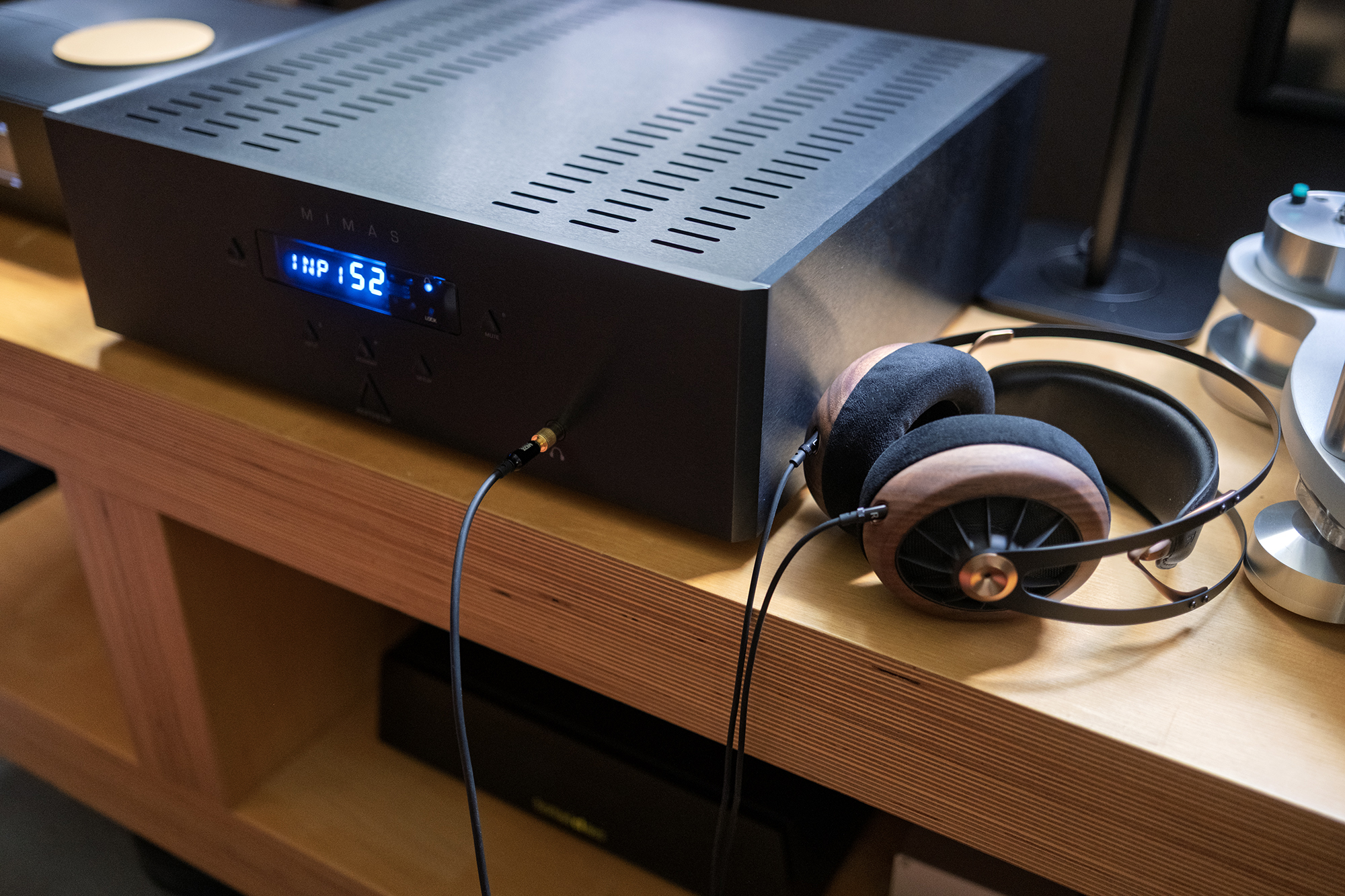
From the liner notes:
Classically trained and raised in Berlin’s club scene, she has garnered critical acclaim for her original, genre-fluid sound rooted in experimental vocals and left-field electronics. Throughout Hymnal, she creates a radical and primal polyphony of innovatively-sampled vocals, in-your-face strings, and futuristic electronic production. These varied elements combine to form an ecstatic genesis, a musical offering that intersects with the minimalism of Steve Reich and Terry Riley, the avant-garde vocal storytelling of Meredith Monk and Laurie Anderson, and the political and communal spirit of American folk and dance music.
More like in-my-head strings which nicely illustrated the Mimas also has headphone-driving chops. As I’ve shared many times before, I prefer in-room sound but nonetheless I heard nothing to complain about here, only engrossing rich music.
There’s a bounce and buoyancy to Smerz’s latest Big city life that the Mimas/Verdande performed perfectly. This is skeletal music in structure, not a lot of extra flesh on the bones, so every aspect of the performance, of the sounds, contribute to the overall mood and message which highlighted the Mimas’ expert ability to control that big 15″ driver in the Ø Audio speakers reproducing the full buoyant bounce of Smerz’s slow swaggering bass lines.
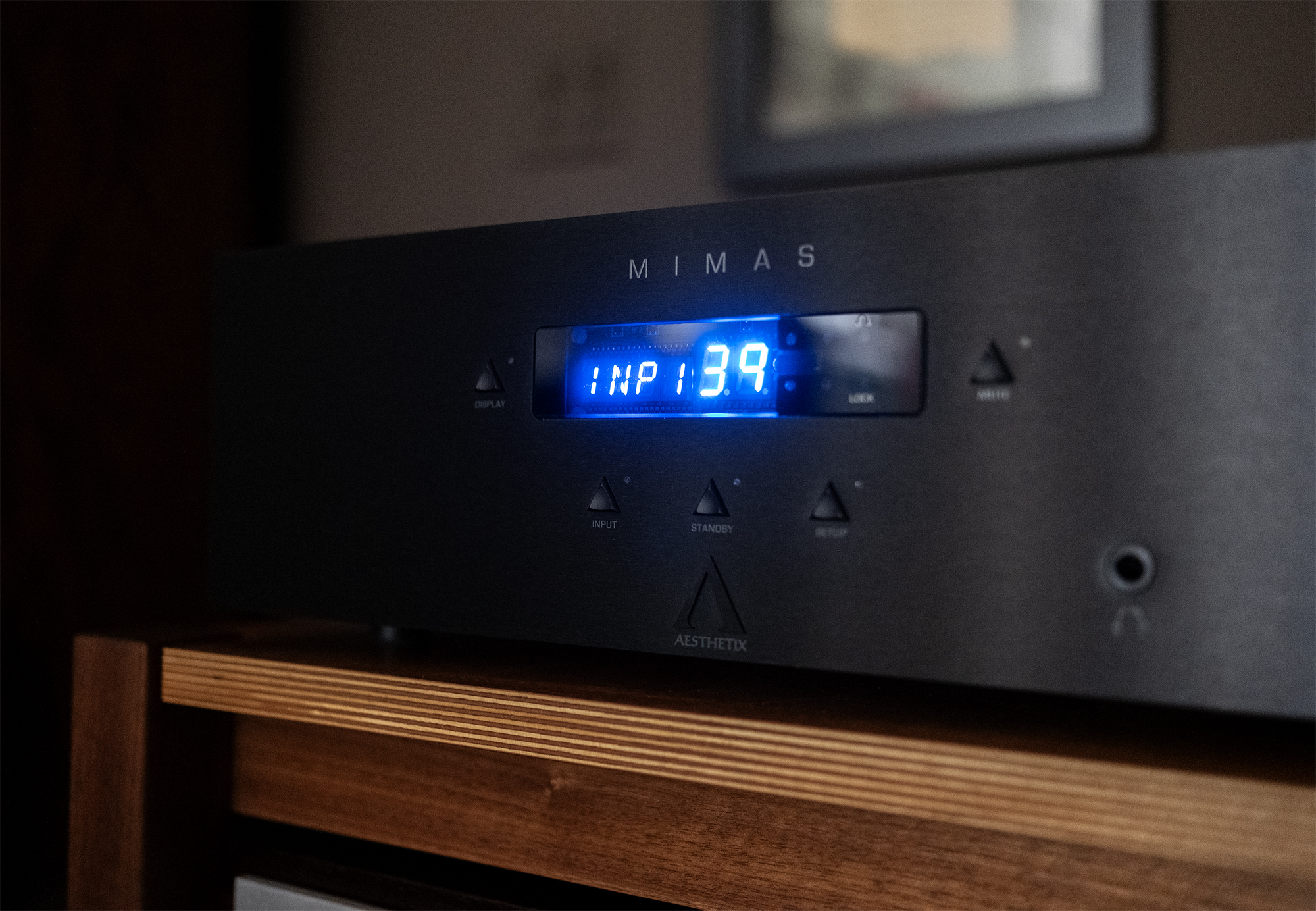
The Mimas arrived in Barn back in April and it has seen lots of play time with three pair of speakers on both sides of the Barn. All to say the few albums highlighted here represent a tiny fraction of all the music I got to relish and roll around in reveling in the ability of music to transform experience and transcend reproduction.
It’s no wonder the Aesthetix Mimas received such glowing reviews upon its arrival and you can add my glowing review to that list. If the mark of a successful hifi design lies in longevity, the Mimas hits that mark as hard as any integrated amplifier to have graced the Barn with truly outstanding performance regardless of price.
Aesthetix Mimas Integrated Amplifier
Price: $9000
Company Website: Aesthetix
Specifications
Power Section:
Power Output: 150W into 8 ohms, <1% THD; 280W into 4 ohms, <1% THD, both channels driven.
Input Impedance: 20Kohms single-ended, 40Kohms balanced
Bandwidth at full power: 4 – 150kHz
Rated THD at full power: <1%
Preamp Section:
Inputs: 5 line RCA or XLR (balanced)
Volume control: switched resistor network volume control with 88 1 dB steps
Dimensions: 17 7/8″ x 17 11/16″ x 5 1/2″ / 43.4 x 44.9 x 14 cm
Weight: 44 lbs / 20 Kg
Shipping weight: 51 lbs / 23 Kg
Finish: black or silver
Warranty: 3 years, non-transferable

